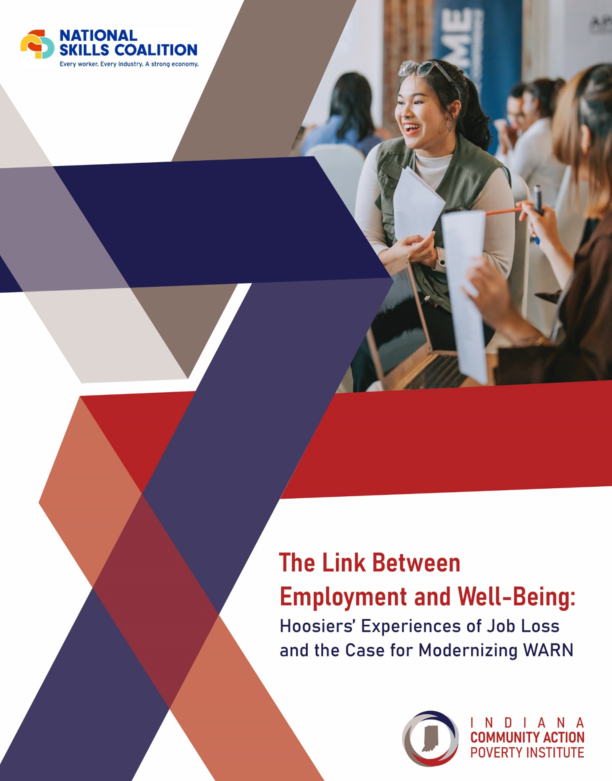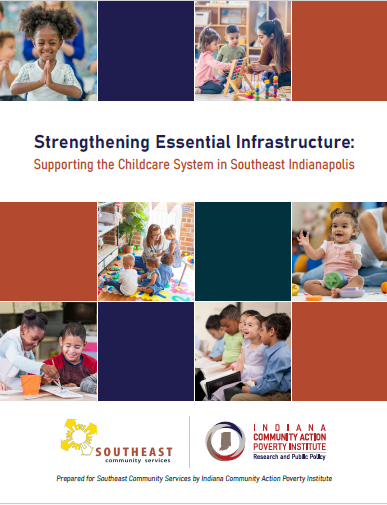Reports
Strong Families, Strong Indiana: The Past, Present, and Future of Indiana's Temporary Assistance for Needy Families
Through a partnership with the Pritzker Children's Initiative, the Institute analyzed the impact of the legislature's 2023 Temporary Assistance for Needy Families (TANF) reform. While there are encouraging signs of progress on both eligibility and benefits, the program will need further reform to better uplift families - especially those with young children - who need short-term cash assistance to remain financially stable.
|
 |
 |
Getting Past "Just Overwhelming:" Equipping La Porte County Residents to Respond to Medical Bills
The Institute partnered with the Health Foundation of La Porte to better understand La Porte County residents' experiences with medical debt and the gaps in knowledge and skills for navigating medical bills. This report describes key takeaways, outreach results, and areas for future work in supporting Hoosiers who are navigating medical bills.
|
The Link Between Employment and Well-Being: Hoosiers' Experiences of Job Loss and the Case for Modernizing WARN
This assessment combines statewide data from the Worker Adjustment and Retraining Notification (WARN) Act with data from the Indiana Community Action Poverty Institute Job Loss Survey, which provides new insight into the harms that Hoosiers experience after losing their jobs. While consensus is rare within survey studies, 100% of respondents to the Indiana Community Action Poverty Institute Job Loss Survey indicated that they would have benefited from increased notice in advance of their job loss, indicating the potential need for policy intervention to better assist in job transitions. Read more for insights on how we can improve job transition experiences for Hoosiers, a policy investment that benefits both workers and employers by smoothing labor market fluctuations.
February 2025 | Report PDF
|
 |
 |
'Billed to the Breaking Point': Harms from Indiana's High Electricity Costs
In collaboration with Citizens Action Coalition, the Institute investigated the rising costs of electricity and the harms that disproportionately fall on low- and middle-income Hoosiers as a result. The Institute finds that even as CEOs of investor-owned utility companies take home millions in compensation packages, increasing numbers of everyday Hoosiers are unable to afford the rising costs of electricity. This raises concerns in an era of climate change, with potentially-deadly consequences for the hundreds of thousands of Hoosiers who face disconnection each year.
November 2024 | Report PDF
|
'Live in Our Shoes for a Day': A Study of Hoosiers Leaving the Workforce Due to Disability
This study examines the experiences of individuals who leave the workforce due to disabling conditions by centering their voices and experiences. It highlights statistics and research studies to illustrate the need for policy reforms and programs that help Hoosiers with disabilities stay on the job, remain financially stable when a transition out of the workforce is needed, and return to the workforce when they are able to do so.
September 2024 | Report PDF
|
 |
 |
Region 9 Strategic Plan: Towards Safe, Stable, Affordable Housing & Community Connections for All
The Institute collaborated with the Region 9 Planning Council ("R9PC") to conduct research and strategic planning process to promote access to safe, stable, and affordable housing and community connections for all Region 9 residents. Stakeholders both within the community, of lived experience, and on the R9PC Leadership Team emphasized the importance of housing, particularly as community members grapple with overlapping difficulties related to health, child well-being, public safety, and economic development. Moving forward, the report and strategic plan will be a valuable resource for Region 9 and beyond to ensure safe and stable housing in all communities.
May 2024 | Download Report
|
Strengthening Essential Infrastructure: Supporting the Childcare System in Southeast Indianapolis
Southeast Community Services (SECS) recognizes that easily-accessible, licensed childcare is essential to both the short- and long-term success of families and communities. Seeking ways to support the expansion of high-quality affordable early learning/childcare opportunities in the Twin Aire neighborhood and the southeast side of Indianapolis more broadly, SECS commissioned the Indiana Community Action Poverty
Institute to explore barriers and opportunities using research literature, quantitative data, and direct engagement with parents, providers, and workers in the community. Our research yielded a rich array of options to strengthen this essential infrastructure.
DECEMBER 2023 | Download Report
|
 |
 |
Payday Lending: A Drain on Hoosier Families and Communities
This update on our 2019 report shows that payday lenders drain over $29 million in finance charges from Hoosier borrowers annually on loans that average $386. Effective January 2023, the maximum payday loan increased from $605 to $715, and lenders can charge rates as high as 391% Annual Percentage Rate (APR). As the report shows, Indiana saw a precipitous drop in loan volume during 2020, likely due to robust federal support in response to the COVID-19 pandemic. Since the expiration of important federal supports such as the expanded Child Tax Credit, additional unemployment insurance, and rental assistance, payday loan volumes are trending toward their pre-pandemic levels.
JUNE 2023 | Download Report
|
Overlooked & Undercounted
Struggling to Make Ends Meet in Indiana
Developing strategies to ensure Indiana households reach economic security requires data that defines how much is enough and which households are struggling. This report reveals the "overlooked and undercounted" of Indiana, describing which families are struggling to make ends meet. This analysis is based on the Self-Sufficiency Standard, a realistic, geographically specific, and family composition- specific measure of income adequacy, and thus a more accurate alternative to the official poverty measure. Over the last 23 years, calculation of the Self-Sufficiency Standard has documented the continuing increase in the real cost of living, illuminating the economic crunch experienced by so many families today.
February 2023 | Download Report
|
 |
 |
Educational Attainment Among Hoosier Adults
The vision for Next Level Jobs says it all: "Two million Hoosiers need additional training to compete in the 21st Century workforce, and there will be over 1 million job openings in Indiana due to retirements and the creation of new jobs by 2025."
Employers need trained workers now.
Helping adults access and persist in post-secondary education and training has to be a bigger part of the solution. Two million Hoosier adults could benefit from additional training now, but they have real barriers to being successful.
January 2023 | Download PDF
|
Advancing Prosperity in Rural Indiana:
Seven priorities for creating thriving rural places, businesses, and families
The rural and small-town way of life is worth fighting for. Hoosiers across rural Indiana deserve a state government that is committed to advancing shared prosperity in their communities. As the ravages of COVID-19 recede, these rural areas stand at a crossroads—they can suffer stagnation, decline, and the loss of people who make rural Indiana so special, or, with the right state laws and policies, they can become places that flourish, grow, and share prosperity broadly among the people who live there. We wrote this report to help state leaders choose the right path for rural Indiana.
June 2022 | Download Report
|
 |
 |
Medical Debt in Indiana
This report discusses the health and social impacts of medical debt, explains how individuals become indebted, provides data about financially vulnerable Hoosiers and statewide trends, summarizes recent government and private action, and recommends policy solutions to address rising medical debt.
June 2022 | Download PDF
|
2020 Statewide Community Needs Assessment
The following report, based on survey data from clients using Community Action Agencies' services across the state as well as data available from the U.S. Census Bureau, gives life to the academic study of poverty. As part of this needs assessment, financially vulnerable Hoosiers were asked about many areas of life that research have shown to contribute to the causes and conditions of poverty. Factors such as educational attainment, debt burden and access to financial services, employment, housing, transportations, health care, food insecurity, and many others. Neighbors and community members say, in their own words, factors that caused their current experience of poverty, what effect poverty has had on their lives, how the pandemic affected the and their families, and what they still need as they work through poverty in a system that is set up to keep some people on the bottom.
June 2022 | Download Report
|
 |
 |
Financial Drain: Payday Lenders Extract Millions from Hoosier Communities
In 2002, the Indiana General Assembly granted payday lenders an exemption to our state's loansharking law, allowing them to charge up to 391% APR. Over the past five years, payday lenders have used that exemption to drain over $300 million in finance charges from Hoosiers, largely in low-income communities and communities of color.
September 2019 | Download Report | Read More
|
The Status of Working Families in Indiana: 2018 Report
Indiana once was a leader in the Midwest in income, poverty, employment rates, and more. Now, with declining standard of living, it faces a choice: continue the low-road policies that brought us here, or focus on policies for working families that will restore broad-based economic prosperity.
August 2018 | Download Report | Read More
|
 |
 |
Wages, Wealth, & Poverty: Where Hoosier Women Stand & Ways Our State Can Close the Gaps
Hoosier women earn less, own less, and experience poverty more often than men. Suggested state policy solutions would address the gaps by giving women the tools to combat pay discrimination, resolving caregiver-worker tensions, improving equity in education, and giving Hoosier women a raise.
DECEMBER 2017 | Download Report | Read More
|
Clearing the Jobs Pathway: Removing Non-Academic Barriers to Adult Student Completion
In order to reach the state's workforce and economic goals, Indiana needs leadership to better align resources for adult students and to remove barriers that stand between them and post-secondary education and training programs.
JUNE 2017 | Download Report | Read More
|
 |
 |
Paid Family and Medical Leave: Policy Analysis and Recommendations for Indiana
This report describes the many benefits of paid family and medical leave for employees, their loved ones, businesses, and the economy and makes recommendations for state legislation that would maximize low-income, working families' ability to take leave.
DECEMBER 2016 | Download Report | Read More
|
The Self-Sufficiency Standard for Indiana 2016
This report presents and analyzes The Self-Sufficiency Standard for Indiana 2016. The measure calculates how much income a family must earn to meet basic needs, with the amount varying by family composition and where they live.
JANUARY 2016 | Download the Report | Read More
|
 |
 |
On the Road: Exploring Economic Security Pathways in Indiana
This report addresses the issue of economic security for Indiana households. The Self-Sufficiency Standard approach to economic security consists of three elements: securing the costs of daily basic needs, creating an emergency savings fund, and choosing the appropriate asset-building Economic Security Pathway(s).
JANUARY 2016 | Download the Report | Read More
|
Archives
2015
2014
2013
2012
2011
2010
2009
2008
2007
2006
2005
|




















